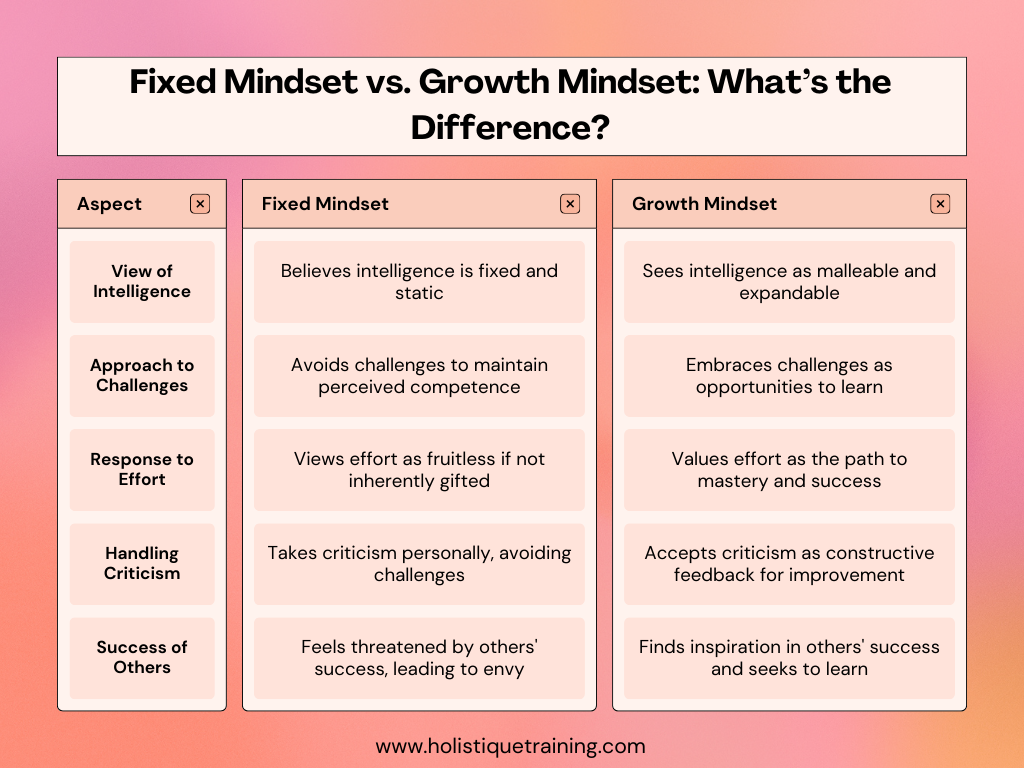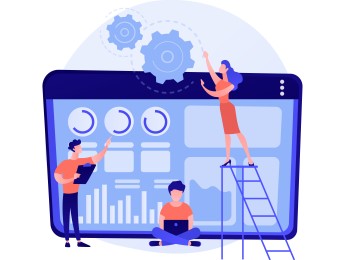- Table of Contents
- Introduction
- Top 10 Challenges Leaders Are Facing Today
- 1- Rapid Technological Changes
- 2- Global Economic Uncertainty
- 3- Remote Work Challenges
- 4- Talent Management and Retention
- 5- Crisis Management
- 6- Diversity and Inclusion
- 7- Environmental and Social Responsibility
- 8- Regulatory Compliance
- 9- Work-Life Balance
- 10- Adapting to Change
- The Importance of Resilience in Leadership
- Resilience
- Growth Mindset vs. Fixed Mindset: What’s the Difference?
- Benefits of Cultivating a Growth Mindset As a Leader
- Increased Adaptability
- Enhanced Problem-Solving Skills
- Motivated Teams
- Resilience in the Face of Setbacks
- Statistics on Cultivating a Growth Mindset in the Workplace
- How to Turn Challenges into Opportunities: Step-by-step
- Step 1: Cultivate a Growth Mindset
- Step 2: Develop Resilience
- Step 3: Encourage Innovation
- Step 4: Invest in Continuous Learning
- Step 5: Promote Collaboration
- Step 6: Evaluate and Learn from Setbacks
- Step 7: Pivot Strategies When Necessary
- Step 8: Leverage Technology and Data
- Step 9: Communicate a Compelling Vision
- Step 10: Celebrate Successes, Learn from Failures
- The Crucial Role of Emotional Intelligence in Facing Leadership Adversities
- Understanding Emotional Intelligence
- How to Cultivate Emotional Intelligence
- How Did the Idea of Resilience in the Workplace Change Post-COVID-19?
- Conclusion
Introduction
Leadership is a journey laden with challenges, each presenting a unique opportunity for growth and development. In the fast-paced and ever-evolving landscape of today's professional world, leaders encounter a myriad of obstacles that test their mettle. In this blog post, we will delve into the top 10 challenges leaders face today and explore the transformative power of resilience and a growth mindset in navigating these hurdles.
Top 10 Challenges Leaders Are Facing Today
In the dynamic landscape of contemporary leadership, professionals at the helm grapple with a diverse range of challenges that demand strategic acumen, adaptability, and foresight. Let's delve into the top 10 challenges that leaders are currently facing:
1- Rapid Technological Changes
In an era defined by the rapid evolution of technology, leaders must continuously navigate the intricate landscape of digital advancements. Adapting to new tools, integrating emerging technologies, and ensuring digital literacy across teams are paramount. The challenge lies not only in staying current but also in leveraging technology for sustainable growth without compromising data security.
2- Global Economic Uncertainty
Global economic uncertainty, influenced by geopolitical shifts, trade tensions, and unexpected events, poses a perpetual challenge for leaders. The ability to anticipate economic trends, mitigate risks, and make informed decisions in unpredictable financial environments is crucial for organisational resilience.
3- Remote Work Challenges
The widespread adoption of remote work has transformed the traditional workplace paradigm. Leaders are tasked with fostering collaboration, maintaining team cohesion, and ensuring productivity in virtual settings. Balancing flexibility with accountability and addressing the unique needs of remote employees present ongoing challenges.
4- Talent Management and Retention
Attracting and retaining top talent in a competitive job market is a perennial challenge for leaders. Strategies for talent acquisition, development, and retention must align with organisational goals. Leaders must also navigate the delicate balance between offering competitive compensation, professional development opportunities, and creating a positive work culture.
5- Crisis Management
The unforeseen crisis, whether global pandemics, financial downturns, or cybersecurity threats, demand leaders to be proactive in their crisis management approach. Developing robust contingency plans, fostering organisational resilience, and exhibiting agility in adapting to unforeseen circumstances are essential leadership skills.
6- Diversity and Inclusion
Promoting diversity and inclusion is not just a legal obligation but a strategic imperative for leaders. Navigating the complexities of diversity requires a commitment to equity and inclusion, fostering a workplace culture that values differences and promotes equal opportunities for all.
7- Environmental and Social Responsibility
As societal expectations evolve, leaders are under increasing pressure to lead with environmental and social responsibility. Balancing profit goals with sustainable practices, ensuring ethical supply chain management, and contributing positively to communities are vital components of contemporary leadership.
8- Regulatory Compliance
Leaders must navigate a labyrinth of regulations and compliance standards that vary across industries and regions. Ensuring adherence to legal requirements, staying updated on regulatory changes, and implementing effective compliance measures are essential for mitigating legal risks.
9- Work-Life Balance
The challenge of promoting work-life balance has intensified in a hyper-connected world where technology blurs the boundaries between professional and personal life. Leaders must champion policies that prioritise employee well-being, foster a healthy work culture, and support a balance between professional and personal commitments.
10- Adapting to Change
The ability to adapt to change swiftly and effectively is a fundamental challenge for leaders. Markets, technologies, and consumer behaviours evolve at an unprecedented pace. Leaders must cultivate organisational cultures that embrace change, encourage innovation, and empower teams to adapt proactively.
In navigating these multifaceted challenges, leaders are not merely problem solvers but architects of transformation. The evolving nature of these challenges demands leaders to be agile, resilient, and visionary in their approach, forging a path to sustainable success in an ever-changing world.
The Importance of Resilience in Leadership
Leadership is akin to navigating a ship through turbulent waters – unpredictable, challenging, and at times, stormy. In this tumultuous journey, resilience emerges as the anchor that steadies the ship and allows leaders to not only weather the storm but also find opportunities amid the adversities.
Resilience
Resilience is more than just bouncing back from setbacks; it is the ability to adapt, grow, and thrive in the face of challenges. For leaders, resilience is the cornerstone of effective leadership in an ever-changing and often volatile business environment.
Bouncing Back from Setbacks
Leaders who cultivate resilience view setbacks not as roadblocks but as stepping stones. Adversity becomes a powerful catalyst for personal and professional growth. These leaders understand that challenges, though formidable, provide invaluable lessons that contribute to their evolution as effective leaders.
Maintaining Composure Under Pressure
Resilient leaders possess the ability to maintain composure under pressure. In moments of crisis, their steady demeanour inspires confidence among team members, fostering a sense of stability and reassurance. This emotional intelligence is a hallmark of resilient leadership.
Inspiring Confidence in Teams
A resilient leader serves as a beacon of hope and inspiration for their team. By demonstrating resilience, they instil confidence in their team's ability to overcome challenges. This collective confidence creates a positive organisational culture that encourages collaboration, innovation, and a shared commitment to success.
Finding Opportunities in Adversity
While adversity may seem like an unwelcome guest, resilient leaders perceive it as an opportunity for growth, innovation, and positive transformation. This paradigm shift transforms challenges from burdens into catalysts for success.
Learning from Setbacks
Resilient leaders view setbacks as valuable learning experiences. Instead of dwelling on failures, they analyse the root causes, extract lessons, and apply newfound knowledge to drive innovation. Every challenge becomes a source of data for refining strategies and approaches.
Fostering a Culture of Continuous Learning
Leaders who find opportunities in adversity prioritise continuous learning within their organisations. They encourage a culture where team members embrace challenges as chances to learn, adapt, and evolve. In such an environment, mistakes are not stigmatised but celebrated as integral to the growth process.
Turning Crisis into Creativity
In times of crisis, resilient leaders tap into their creative reservoirs. Adversity sparks innovation, prompting leaders to explore unconventional solutions, pivot strategies, and discover new avenues for success. It is during these challenging times that the seeds of innovation are sown and creativity flourishes.
Growth Mindset vs. Fixed Mindset: What’s the Difference?
The concept of a growth mindset, popularised by psychologist Carol Dweck, emphasises the belief that abilities and intelligence can be developed through dedication and hard work. In contrast, a fixed mindset assumes that intelligence and abilities are fixed traits and cannot be significantly changed.

Leaders with a growth mindset perceive challenges as opportunities to learn and improve. They welcome feedback, view failures as stepping stones to success, and are more resilient in the face of setbacks. On the other hand, leaders with a fixed mindset may avoid challenges, fearing failure and the perception of inadequacy.
Benefits of Cultivating a Growth Mindset As a Leader
Increased Adaptability
Leaders with a growth mindset are more adaptable, embracing change and leveraging challenges to drive innovation.
Enhanced Problem-Solving Skills
A growth mindset fosters a problem-solving orientation, empowering leaders to approach challenges with creativity and resourcefulness.
Motivated Teams
Leaders who cultivate a growth mindset inspire their teams to persevere through challenges, fostering a culture of continuous improvement and achievement.
Resilience in the Face of Setbacks
The belief that setbacks are temporary and can be overcome fuels resilience, allowing leaders to navigate challenges with confidence.
Statistics on Cultivating a Growth Mindset in the Workplace
According to HBR, in a company fostering a growth mindset, employees experience notable benefits. They are 47% more likely to perceive their colleagues as trustworthy, indicating a positive and collaborative work environment. Additionally, there is a 34% increase in the likelihood of employees feeling a strong sense of ownership and commitment to the company, reflecting a high level of dedication. Furthermore, a 65% higher likelihood exists for employees to believe that the company supports risk-taking, fostering an innovative and dynamic organizational culture. This supportive atmosphere results in a 49% higher likelihood of employees expressing that the company actively nurtures innovation.
How to Turn Challenges into Opportunities: Step-by-step
Navigating the complex terrain of leadership involves not only recognising challenges but transforming them into catalysts for growth and innovation. In the dynamic landscape of today's business world, effective leaders don't just confront obstacles; they convert them into stepping stones towards success. Here's a step-by-step guide on how to turn challenges into opportunities:
Step 1: Cultivate a Growth Mindset
The foundation of transforming challenges lies in the mindset of the leader. Embrace a growth mindset that views challenges as opportunities for learning and improvement. Encourage your team to adopt this perspective, fostering a culture that values resilience, adaptability, and a positive approach to setbacks.
Step 2: Develop Resilience
Resilience is the bedrock of effective leadership in the face of challenges. Equip yourself and your team with the tools to bounce back from setbacks. Foster an environment where failure is not stigmatised but viewed as a natural part of the learning process. Develop coping mechanisms that promote emotional intelligence and the ability to face adversity with composure.
Step 3: Encourage Innovation
Challenge the status quo by fostering a culture of innovation within your organisation. Encourage your team to think creatively, explore unconventional solutions, and embrace change as an opportunity for improvement. Actively seek input from diverse perspectives, recognising that innovation often emerges from collaboration and the clash of different ideas.
Step 4: Invest in Continuous Learning
Turn challenges into opportunities for growth by investing in continuous learning. Prioritise professional development for yourself and your team. Provide resources, training programs, and mentorship opportunities that enable individuals to acquire new skills and stay ahead of industry trends. A commitment to learning positions your organisation to navigate challenges with informed strategies.
Step 5: Promote Collaboration
Break down silos and promote collaboration across teams. Challenges are often multifaceted, requiring diverse skills and perspectives for effective solutions. Foster an environment where open communication, knowledge sharing, and cross-functional collaboration are valued. Teamwork not only enhances problem-solving but also cultivates a sense of collective responsibility.
Step 6: Evaluate and Learn from Setbacks
When challenges arise, conduct thorough evaluations to understand the root causes and underlying dynamics. View setbacks as opportunities for introspection and improvement. Implement a feedback loop that encourages open communication about what worked, what didn't, and how processes can be refined. This iterative approach positions your organisation to continually evolve and adapt.
Step 7: Pivot Strategies When Necessary
Recognise that challenges may require a shift in strategy. Leaders who can pivot and adapt their approaches in response to changing circumstances are better equipped to seize emerging opportunities. Flexibility is a key attribute in turning challenges into launching pads for success.
Step 8: Leverage Technology and Data
In the digital age, technology and data can be powerful allies in overcoming challenges. Embrace innovative technologies that enhance efficiency, analyse data to informdecision-making, and leverage digital tools for strategic advantage. Turning challenges into opportunities often involves harnessing the capabilities of the digital landscape.
Step 9: Communicate a Compelling Vision
During challenging times, clear and inspirational communication is crucial. Articulate a compelling vision that aligns with the values and aspirations of your team. Help them understand the purpose behind overcoming challenges and how it contributes to the overall success of the organisation. A shared vision creates a sense of purpose and unity.
Step 10: Celebrate Successes, Learn from Failures
As you navigate challenges and turn them into opportunities, celebrate successes, both big and small. Acknowledge the efforts of your team and highlight achievements. Equally important is learning from failures. Conduct post-mortems with a constructive focus, extracting valuable lessons that contribute to continuous improvement.
In the dynamic landscape of leadership, the ability to turn challenges into opportunities is a hallmark of transformational and visionary leaders. By following these steps, leaders can create a culture where challenges are not roadblocks but stepping stones towards organisational success and sustained growth.
The Crucial Role of Emotional Intelligence in Facing Leadership Adversities
In the intricate dance of leadership, emotional intelligence emerges as a guiding light, illuminating the path through challenges and adversities. Leaders who harness the power of emotional intelligence navigate stormy seas with finesse, influencing not just outcomes but also the emotional landscape of their teams.
Understanding Emotional Intelligence
Emotional intelligence involves the ability to recognise, understand, and manage one's own emotions, as well as effectively navigate and influence the emotions of others. For leaders facing adversities, this skill set is a linchpin that determines not only their personal resilience but also the collective emotional climate of the organisation.
1. Self-Awareness
Leaders with high emotional intelligence possess a keen awareness of their own emotions. In the face of challenges, self-awareness becomes the anchor that prevents emotional turbulence from escalating. The importance of self-awareness doesn’t stop there, though. Research conducted over a span of 30 months, analysing 486 companies, revealed that organisations boasting a greater proportion of self-aware leaders consistently outperformed those with a lower prevalence of self-awareness among their leadership. By understanding their emotional responses, leaders can make conscious decisions, maintain composure, and project a sense of stability to their teams.
Table 1: Ways to Become More Self-Aware
Self-Awareness Techniques | Benefits | Implementation Tips |
1. Reflective Journaling | Enhances insight and personal growth | Set aside dedicated time for introspective writing. |
2. Feedback Solicitation | Gains external perspectives for self-awareness | Create a culture that encourages open feedback. |
3. Mindfulness Practices | Fosters present-moment awareness and clarity | Incorporate short mindfulness exercises daily. |
4. 360-Degree Assessments | Provides holistic feedback for comprehensive self-awareness | Encourage honest and constructive feedback from peers. |
5. Leadership Coaching | Guided one-on-one support for personal insight | Engage in regular coaching sessions for continuous growth. |
2. Self-Regulation
Adversities can trigger a spectrum of emotions, from frustration to anxiety. Leaders with strong emotional intelligence excel in self-regulation, the ability to manage and control their emotional reactions. This steadiness under pressure fosters a sense of calm within the team, inspiring confidence and providing a solid foundation for problem-solving.
3. Empathy
Empathy, a hallmark of emotional intelligence, is instrumental in leadership during challenges. Leaders who can understand and share the feelings of their team members create a supportive environment. By acknowledging and validating emotions, leaders build trust and strengthen the team's resolve to face challenges collaboratively. Also,statistics show that leaders who exhibit empathy demonstrate a remarkable 40% improvement in employee engagement, decision-making, and coaching effectiveness.
4. Effective Communication
Communication is a powerful tool for leaders navigating adversity, and emotional intelligence enhances its impact. Leaders adept in emotional intelligence communicate not just with words but with empathy and understanding. Crafting a narrative that acknowledges challenges while instilling hope and a shared sense of purpose inspires the team to persevere.
5. Relationship Management
Leadership adversities often test the fabric of team relationships. Emotional intelligence enables leaders to navigate interpersonal dynamics with finesse, resolving conflicts, and fostering collaboration. By actively managing relationships, leaders contribute to a resilient team culture that withstands challenges through shared trust and mutual support.
How to Cultivate Emotional Intelligence
1- Self-Reflection and Assessment
Regularly assess your emotional responses to challenges, seeking to understand triggers and patterns. This self-awareness lays the groundwork for enhanced emotional intelligence.
2- Continuous Learning and Development
Invest in resources and programs that enhance emotional intelligence skills. Training in empathy, communication, and conflict resolution contributes to your ability to navigate adversities effectively.
3- Create a Supportive Environment
Foster a workplace culture that values emotional intelligence. Encourage open communication, provide resources for emotional well-being, and model the principles of empathy and resilience.
4- Lead by Example
Demonstrate emotional intelligence in your leadership style. Model self-regulation, empathy, and effective communication, setting the tone for the organisation's emotional climate during challenges.
In the tapestry of leadership, emotional intelligence is the thread that weaves resilience, empathy, and effective communication. Leaders who embrace and cultivate this skill set not only navigate adversities with grace but also empower their teams to face challenges with a collective strength that transcends individual capabilities.
How Did the Idea of Resilience in the Workplace Change Post-COVID-19?
The COVID-19 pandemic ushered in an unprecedented era of uncertainty, forcing leaders to confront new and complex challenges. The need for resilience became more apparent than ever as organisations navigated the abrupt shift to remote work, economic volatility, and the human impact of the crisis.
Post-COVID-19, resilience in the workplace evolved from being a desirable trait to a critical skill. Leaders who demonstrated agility, adaptability, and compassion during the pandemic not only steered their organisations through tumultuous times but also set the stage for a more resilient future.
Conclusion
In conclusion, the challenges leaders face today are multifaceted and ever-evolving. However, by embracing a growth mindset, cultivating resilience, and viewing challenges as opportunities for growth, leaders can not only navigate adversity but also thrive in the face of uncertainty. The journey from challenge to opportunity is a transformative one, shaping leaders into visionaries capable of steering their teams and organisations toward sustained success.
In the dynamic world of leadership, where challenges morph into opportunities, the journey to mastery requires continuous learning and skill refinement. Perfecting Your Management and Leadership Skills is not just a course; it's your gateway to unlocking the secrets of effective leadership. Dive into a curriculum crafted to enhance your growth mindset, fortify your resilience, and equip you with the emotional intelligence needed to navigate the complexities of leadership. Join us on this transformative journey where challenges become the stepping stones to unparalleled success. Elevate your leadership prowess and steer your team toward triumph in the face of uncertainty. Enrol now in Perfecting Your Management and Leadership Skills and chart a course towards leadership excellence. Your journey to visionary leadership begins here.
























